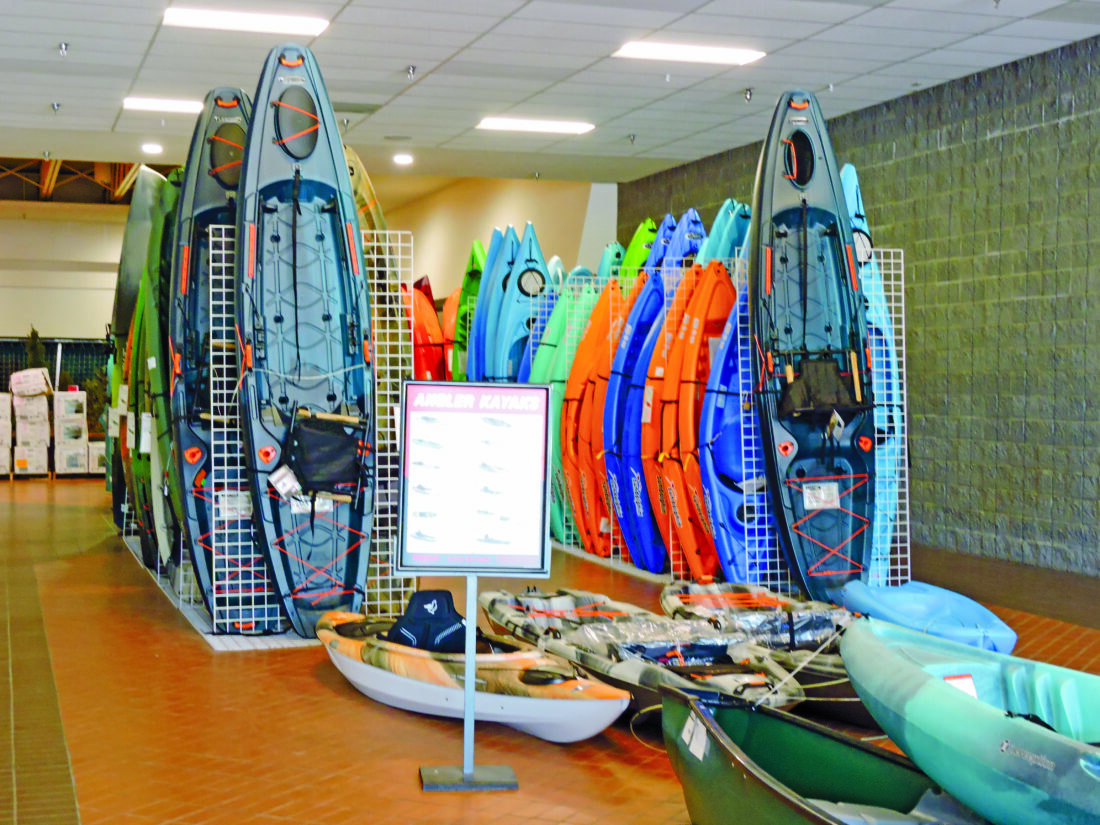Kayaking: A personal adventure in getting started

Graham Jaehnig/Daily Mining Gazette While buying a kayak is a simple process, trying to decide which one is right for you can seem overwhelming. This display of kayaks can be overwhelming to some. The two in the foreground are sit-on-top fishing or angling kayaks. Each has a different type of seat. The display on the right, behind the angler kayak, are a mix of sit-inside and sit-on top kayaks, of various lengths, widths, shapes, colors and options.
Part One: Which kayak is right for you?
Like so many other Copper Country residents, I’m getting older. And like so many other Copper Country residents, I’m doing it with a number of physical issues, not the least of which is having broken my lower back three times. Yet, I still have a spirit of adventure, and I’ve realized that there are new things I would like to experience while my body still functions relatively well. One of the activities I decided to try was kayaking. Just selecting a kayak that I could physically move, on and off the water, became an adventure in itself and the inspiration for this series. For other Copper Country residents with physical limitations who have contemplated beginning kayaking — or anyone else for that matter — hopefully this series will take a lot of guesswork out of the process. While I do not claim to be an expert on kayaks or kayaking, sharing my experiences and what I have learned along the way will hopefully provide some information on the topic and how and where to begin.
Unless you know someone already involved in kayaking who can help you, finding out what types of kayaks are available and which one will best fit your needs cannot only be challenging, it can seem overwhelming. There are so many to choose from.
There are recreational kayaks, touring kayaks and sea kayaks. Some are designed for flat water and slow-moving streams. Others are designed for what is called white-water kayaking, which is primarily fast-moving rivers and rapids. Touring kayaks are designed for extended, multiday trips. Then, there are sea kayaks, which are designed for open waters and can handle waves, like those on “Big” Portage Lake or Lake Superior. Kayaks are also manufactured using various materials, such as Polyethylene, a type of plastic, fiberglass, composite materials and so on. There are pros and cons to each material; those will be discussed later.
Recreational kayaks are almost always intended for flat water such as small inland lakes, bays and slow moving rivers. Among the recreational kayaks there are sit-inside and sit-on-top types. Some are designed for leisurely paddling on a calm lake for an hour or two. Others are designed for fishing. There are pros and cons in considering a sit-inside versus a sit-on-top; among them is the weight of the kayak, transporting it, loading it and unloading it on and off your vehicle, carrying it to and from the water, and so on.
Recreational kayaks are most often short, about 10 to 12 feet long and are 29 to 30 inches wide, which makes them very stable on the water and easy to maneuver and turn. They are intended for inland lakes like Prickett, in Baraga County, Seneca Lake, in Keweenaw County, Boston Lake (pond) and Calumet Lake, in Houghton County, and Mirror Lake, in Ontonagon County. The sit-inside types are usually lighter than other types of kayaks, and therefore easier to lift, load and unload.
Touring kayaks are generally longer at 12 to 15 feet and narrower, usually about 28 inches. Because they are longer and narrower, touring kayaks are easier to paddle for longer distances and “track” better than shorter kayaks, meaning it is easier to keep them moving in a straight line between strokes. Touring kayaks have safety features recreational kayaks lack, such as bulkheads in front of and behind the cockpit, where the paddler sits. The bulkheads form water-tight compartments that not only prevent the craft from sinking in the event of a capsize, but also provide storage space for the items necessary for camping on extended paddling trips. The compartments are provided with deck hatches that allow access to them for storage. While they can be used on flat water, they can handle rougher waters like “Big” Portage Lake, or not so rough days on Lake Superior, close to shore.The terms touring kayak and sea kayak are sometimes interchangeable.
Sea kayaks, however, are usually longer and narrower, and are designed for rougher waters, such as Lake Superior, or oceans. Like touring kayaks, sea kayaks have water-tight bulkheads that are equipped hatch covers, and can be used for multi-day trips.
Having a basic idea of the types of kayaks available can help you decide what type of kayaking you would like to do. Having an understanding of the type of kayaking you see yourself doing is important to helping you decide what kind of kayak to look for.
Almost all online searches asking the question “what type of kayak is the best for beginners?” return the answer “recreational kayaks.” With that in mind, my next installment will examine types of recreational kayaks.






